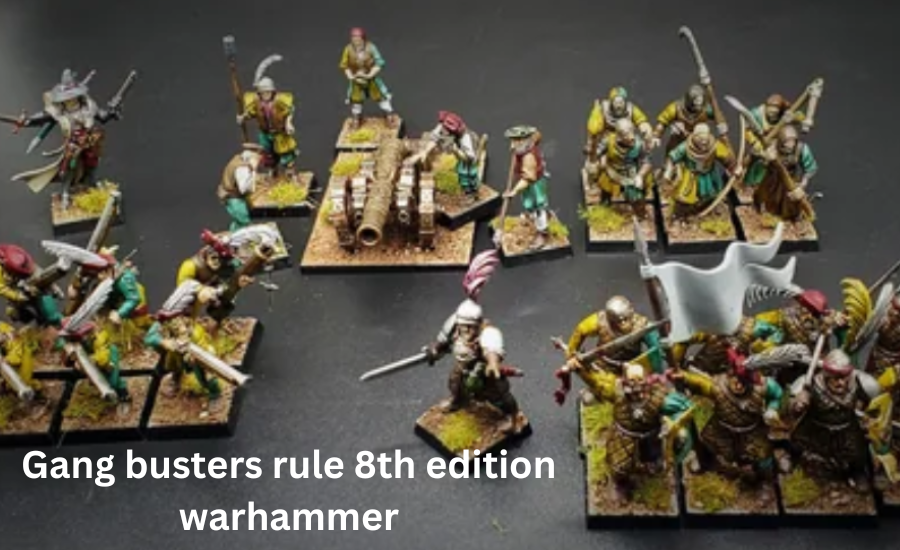Introduction
If you’re a passionate Warhammer enthusiast aiming to enhance your strategic gameplay, mastering the Gang Busters Rule 8th Edition Warhammer is crucial. This rule adds a layer of depth and opens up numerous tactical opportunities, making it a favorite among seasoned players. Whether you’re new to Warhammer or a long-time player, the intricacies of this rule offer something valuable to everyone.
In this guide, we’ll delve into the origins of the Gang Busters Rule, explore its core elements, and provide strategies for maximizing its potential. Additionally, we’ll hear from experienced players and speculate on how this rule might evolve in future editions of Warhammer. Whether you’re looking to deepen your game knowledge or gain a competitive edge, this comprehensive exploration of the Gang Busters Rule in the 8th Edition will equip you with the insights needed to dominate the battlefield.
The Development of the Gang Busters Rule: A Historical Overview

The Gang Busters Rule has a rich history that has evolved in tandem with the Warhammer series, reflecting the growing intricacies of the game. Initially introduced as a specialized mechanic, it quickly became a favorite among players for the strategic depth it brought to the battlefield. Over time, each new edition of Warhammer has fine-tuned this rule, striking a balance between fairness and the pursuit of tactical superiority.
In the 8th Edition of Warhammer 40k, the Gang Busters Rule represents the pinnacle of this evolution, incorporating the most effective strategies and insights from earlier versions. By understanding the rule’s development, players can better grasp the sophistication of the current gameplay while staying ahead of potential future updates. This historical perspective not only sharpens your tactical approach but also enriches your overall Warhammer experience, especially in mastering the Gang Busters Rule in the 8th Edition.
The Impact of Secondary Objectives: Insights from the Gang Busters Rule

In Warhammer 40K’s 8th Edition, the Gang Busters Rule exemplifies how secondary objectives can profoundly influence the game’s meta and overall strategy. As one of the standout objectives, it showcases how these elements can reshape tactical decisions, leading to more dynamic and challenging gameplay. The Gang Busters Rule, in particular, highlights the significant role secondary objectives play in transforming the flow of the game, emphasizing their importance in achieving victory. For players focusing on the “Gang Busters Rule 8th Edition Warhammer,” mastering these objectives is crucial to gaining a competitive edge.
Promoting Versatility
The Gang Busters Rule highlights the critical role of diversity in army composition within Warhammer 40K. By discouraging an overreliance on multi-wound units, this rule encourages players to build more balanced and adaptable army lists. This shift not only deepens the strategic elements of the game but also creates a more dynamic and engaging competitive scene. For those focusing on the “Gang Busters Rule 8th Edition Warhammer,” this lesson in versatility is key to crafting a well-rounded approach.
Emphasizing Strategic Excellence
The Gang Busters Rule in the 8th Edition Warhammer 40K emphasizes the value of strategic, skillful play. Players who effectively target and dismantle multi-wound units are rewarded with critical points, while those who fail to do so find themselves at a disadvantage. This focus on tactical decision-making raises the stakes in every battle, encouraging players to refine their strategies and elevate their overall gameplay.
Balancing Risk with Reward
The Gang Busters Rule masterfully illustrates the balance between risk and reward in game mechanics. While it provides strong incentives to target multi-wound units, it also requires players to carefully consider the potential risks involved. This added layer of complexity ensures that each decision is more strategic and impactful, enhancing the overall experience in Warhammer 40K. For those mastering the “Gang Busters Rule 8th Edition Warhammer,” understanding this balance is essential to achieving success on the battlefield.
The Role of Multi-Wound Units in the 8th Edition
Multi-wound units have long been a pivotal element in Warhammer 40K, offering a unique blend of durability and power that bridges the gap between the resilience of vehicles and the sheer numbers of standard infantry. Elite units such as Space Marine Terminators, Tyranid Warriors, and Crisis Battlesuits are highly valued for their ability to withstand more damage than regular infantry, making them essential assets on the battlefield.
However, the introduction of the Gang Busters Rule in the 8th Edition Warhammer shifted the dynamics surrounding these units. This rule made multi-wound units attractive targets for opponents aiming to score secondary objective points, compelling players to reconsider their strategies. As a result, deploying these units became more challenging, requiring players to exercise greater caution and develop tactics to protect them from focused enemy attacks. This evolution added a new layer of strategic depth to the game, particularly for those mastering the Gang Busters Rule in the 8th Edition Warhammer.
Optimizing Points with the Gang Busters Rule: Essential Strategies and Techniques
To fully leverage the Gang Busters Rule in the 8th Edition Warhammer, players must tailor their strategies to their army’s strengths and the specific challenges posed by their opponent. Here are some key tactics to help you maximize your points:
Strategic Targeting
The Gang Busters Rule rewards players for damaging multi-wound units, so it’s crucial to prioritize targets that will yield the most points. Focus on elite infantry units that are integral to your opponent’s strategy and are likely to be heavily involved in the battle. By concentrating on these high-value targets, you can apply consistent pressure, gradually reducing their effectiveness and maximizing your point accumulation.
Optimal Weapon Selection
Choosing the right weapons is vital for optimizing your points under the Gang Busters Rule. Weapons with high rates of fire and significant damage output are particularly effective against multi-wound units. Consider options like plasma guns or heavy bolters that can consistently inflict damage over multiple turns, allowing you to chip away at tough enemies and efficiently increase your point total.
Concentrated Firepower
Focusing your attacks on a single multi-wound unit rather than spreading them across multiple targets can be more effective. By concentrating your fire on one unit at a time, you increase your chances of eliminating it quickly, leading to faster point gains. This focused approach not only disrupts your opponent’s plans but also maximizes your scoring efficiency under the Gang Busters Rule.
Patience and Timing
Timing is critical when playing to the Gang Busters Rule. Instead of rushing your attacks, wait for the perfect moment to strike, when you can deliver a concentrated, decisive blow. Patience allows you to catch your opponent off-guard and capitalize on weaknesses, leading to more effective damage and higher scores.
Integrating with Other Rules
The Gang Busters Rule doesn’t operate in isolation; it works best when integrated with other rules and objectives in your strategy. Consider how this rule complements your army’s primary goals and overall tactical approach. For example, pairing Gang Busters with objectives focused on board control can create synergistic opportunities, enhancing your scoring potential and reinforcing your strategic dominance.
By employing these strategies, players can maximize their points and effectiveness with the Gang Busters Rule 8th Edition Warhammer, gaining a decisive edge on the battlefield.
Advanced Tactics: Defending Against the Gang Busters Rule

The Gang Busters Rule in the 8th Edition Warhammer poses a significant challenge, particularly for armies that rely heavily on multi-wound units. To protect these valuable assets and diminish the effectiveness of this rule, consider implementing the following advanced strategies:
Utilizing Distraction Units
One effective tactic to counter the Gang Busters Rule is to deploy low-value or single-wound units as distractions. Units like Guardsmen or Ork Boyz can draw enemy fire away from your more valuable multi-wound models. By strategically positioning these less critical troops in the line of fire, you can absorb the damage that would otherwise be directed at your elite infantry. This approach not only shields your key units but also forces your opponent to waste resources on less impactful targets, reducing their ability to capitalize on the Gang Busters Rule in the 8th Edition Warhammer.
Dispersing Your Forces
To further mitigate the impact of the Gang Busters Rule, it’s crucial to avoid clustering your multi-wound units together. Grouping these units makes it easier for your opponent to focus their fire and rack up Gang Busters points. Instead, spread your forces across the battlefield to dilute the enemy’s firepower. By dispersing your units, you make it more challenging for your opponent to concentrate their attacks on any single target, thereby reducing the efficiency of their Gang Busters strategy.
Establishing Denial Zones
Creating denial zones on the battlefield can be a highly effective way to protect your multi-wound units from the Gang Busters Rule. Use terrain to your advantage by establishing barriers or positioning your units in areas that are difficult for the enemy to engage without exposing themselves to significant risk. By forcing your opponent to take considerable risks to target your valuable models, you can shield these units from being easily picked off and prevent your opponent from scoring Gang Busters points.
Minimizing Exposure
Another key strategy to counter the Gang Busters Rule involves minimizing the exposure of your multi-wound units to enemy attacks. Use movement and terrain strategically to keep your valuable models out of the enemy’s line of sight whenever possible. Only expose these units when it is absolutely necessary, such as when delivering a decisive blow. By carefully managing their visibility on the battlefield, you can protect your multi-wound units from becoming easy targets and significantly reduce your opponent’s chances of earning points through the Gang Busters Rule in the 8th Edition Warhammer.
By incorporating these advanced tactics into your gameplay, you can effectively counter the Gang Busters Rule and maintain the integrity of your multi-wound units, ensuring they remain a formidable force on the battlefield.
Competitive Impact: How Tournaments Adapted to the Gang Busters Rule

The introduction of the Gang Busters Rule in Warhammer 40K’s 8th Edition brought about a substantial shift in the competitive scene, particularly in how tournaments were played. This new rule significantly altered the meta, forcing players to rethink their strategies and adapt to a more complex secondary objective system. As a result, army compositions and playstyles evolved to strike a better balance between durability and scoring potential, reshaping the competitive landscape.
Influence on Army Composition
One of the most notable effects of the Gang Busters Rule was the increased focus on creating balanced army lists. In the past, players could heavily rely on multi-wound units to dominate the battlefield. However, with the introduction of this rule, relying solely on these units became a risky strategy. Opponents could now target multi-wound units to score Gang Busters points, making them a liability if not used strategically. This shift led to a more diverse range of army compositions, where players began to integrate both single-wound and multi-wound units to minimize the risk of conceding easy points and to maintain flexibility in their tactics.
Enhanced Strategic Depth
The Gang Busters Rule also added a new layer of strategic depth to competitive matches. Players were required to be more thoughtful in their positioning and target selection, as every decision could significantly impact the game’s outcome. The rule encouraged a more dynamic style of play, where players had to anticipate their opponent’s moves and counter them effectively. This emphasis on strategic planning and calculated risk-taking made competitive games more engaging and unpredictable, enhancing the overall experience for both players and spectators.
Evolution of the Meta
As the Gang Busters Rule became a staple in tournaments, it influenced the evolution of the competitive meta. Players who previously relied on brute force and durable units had to adapt to a more nuanced approach, where tactical finesse and adaptability became crucial. This evolution led to the emergence of new strategies and playstyles, fostering a more diverse and vibrant competitive environment. The rule’s impact was felt across various levels of play, from local events to major tournaments, as it pushed players to innovate and refine their approaches to stay competitive.
You May Also Like: 110-35-51
Gang Busters Rule: Anticipating Future Editions

As Warhammer 40K continues to evolve, the lessons learned from the Gang Busters Rule in the 8th Edition are poised to influence future iterations of the game. The significant impact this rule had on the competitive meta illustrates how secondary objectives can shape gameplay and strategy, suggesting that future editions may build upon these concepts to further enhance the depth and balance of the game.
Evolving Secondary Objectives
In future editions of Warhammer 40K, we may see the refinement of secondary objectives similar to the Gang Busters Rule. Game designers could look to develop objectives that not only challenge players but also encourage more varied and dynamic army compositions. This might involve recalibrating point allocations or introducing new mechanics that incentivize creative strategies and tactical ingenuity. By refining these objectives, future editions could offer even more layers of complexity, pushing players to think critically and adapt to an ever-changing battlefield.
Adapting to the Shifting Meta
As the Warhammer 40K meta continues to shift, it’s crucial for secondary objectives to evolve in order to remain relevant and effective. The Gang Busters Rule was particularly successful in addressing the over-reliance on multi-wound units, a trend that had become dominant in the 8th Edition. Future objectives will need to address emerging trends or challenges within the competitive scene, ensuring that the game remains balanced and engaging. Continuous updates and adjustments will be necessary to keep pace with the evolving dynamics of competitive play, allowing the game to stay fresh and challenging.
Faction-Specific Balancing
The introduction of the Gang Busters Rule also highlighted the importance of balancing secondary objectives across different factions. Some factions were more affected by the rule than others, underscoring the need for careful consideration in future editions. Designers might explore the possibility of faction-specific secondary objectives or alternative scoring methods tailored to each faction’s unique characteristics. This approach would ensure that all armies have an equal opportunity to compete effectively, regardless of their inherent strengths or weaknesses, fostering a more inclusive and balanced competitive environment in future editions of Warhammer 40K.
Summary
The Gang Busters Rule from the 8th Edition of Warhammer 40K has introduced significant changes to competitive gameplay, emphasizing the need for strategic targeting of multi-wound units. This secondary objective has led players to adapt their army compositions and tactics, balancing their forces to avoid the pitfalls of relying solely on durable units. By rewarding players for inflicting damage on multi-wound targets, the rule promotes a more dynamic and versatile approach to army building and strategy. It has reshaped tournament play by encouraging diverse army lists and deeper strategic planning, leading to more engaging and unpredictable matches. The influence of the Gang Busters Rule suggests that future editions of Warhammer 40K may continue to evolve secondary objectives to enhance game balance and strategic depth, ensuring that all factions can compete effectively and maintain a fresh, challenging competitive environment.
FAQs
Q1: What is the Gang Busters Rule in the 8th Edition of Warhammer 40K?
A1: The Gang Busters Rule is a secondary objective introduced in the 8th Edition of Warhammer 40K. It rewards players for targeting and inflicting damage on multi-wound units, adding a strategic layer to the game and influencing army composition and tactics.
Q2: How does the Gang Busters Rule affect army composition?
A2: The rule encourages players to avoid over-reliance on multi-wound units, promoting more balanced and versatile army lists. This shift reduces the risk of conceding easy points and enhances the overall strategic depth of the game.
Q3: What are some effective strategies for maximizing points with the Gang Busters Rule?
A3: Effective strategies include prioritizing high-value multi-wound targets, using weapons with high damage output, focusing fire on single units to eliminate them quickly, and timing attacks carefully. Integrating the rule with other objectives can also enhance your scoring potential.
Q4: How can players defend against the Gang Busters Rule?
A4: Defending against the rule involves deploying distraction units to absorb enemy fire, spreading multi-wound units across the battlefield to reduce focus, creating denial zones with terrain, and minimizing the exposure of valuable units to enemy attacks.
Q5: What impact did the Gang Busters Rule have on competitive tournaments?
A5: The rule significantly influenced tournament play by promoting balanced army compositions and adding a new layer of strategic complexity. It required players to adapt their strategies and fostered a more diverse competitive environment.
Q6: How might future editions of Warhammer 40K build on the Gang Busters Rule?
A6: Future editions may refine secondary objectives similar to the Gang Busters Rule to enhance gameplay. This could involve adjusting point criteria, introducing new mechanics, and ensuring faction-specific balance to maintain competitive fairness and strategic depth.
Read Next: Essential Discover





